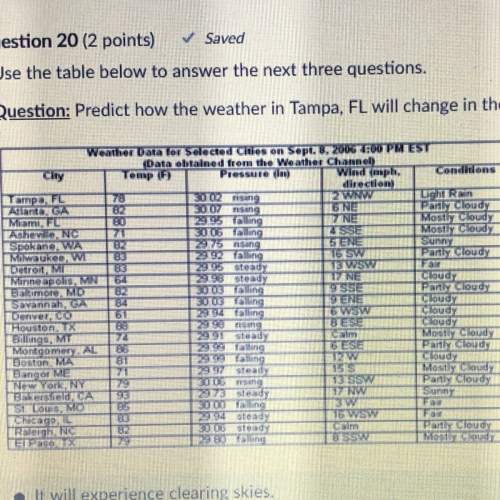
The latent heat of vaporization for water at room temperature is 2430 J/g.
1. How much kinetic energy does each water molecule that evaporates possess before it evaporates?
2. Find the pre-evaporation rms speed of a water molecule that is evaporating.
3. What is the effective temperature of these molecules (modeled as if they were already in a thin gas)?
4. Why do these molecules not burn you
a. These molecules got to be slow-moving in collisions that made other molecules fast-moving; the average molecular energy decreases.
b. These molecules got to be slow-moving in collisions that made other molecules fast-moving; the average molecular energy is unaffected.
c. These molecules got to be fast-moving in collisions that made other molecules slow-moving; the average molecular energy is unaffected.
d. These molecules got to be fast-moving in collisions that made other molecules slow-moving; the average molecular energy increases.

Answers: 2
Another question on Physics

Physics, 21.06.2019 23:10
6–55 refrigerant-134a enters the condenser of a residential heat pump at 800 kpa and 358c at a rate of 0.018 kg/s and leaves at 800 kpa as a saturated liquid. if the compressor consumes 1.2 kw of power, determine (a) the cop of the heat pump and (b) the rate of heat absorption from the outside air.
Answers: 2

Physics, 22.06.2019 08:40
When temperature of a substance increases, of its particles increase resulting in more between particles. real world applications of thermal expansion absolute zero (-273 degrees c) is the lowest possible temperature on the kelvin scale. it is a measure of where a substance has no kinetic energy. heat is a process of the . energy flows spontaneously from a object to a until equilibrium is reached. heat is measured in heat is transferred throughis a method of heat transfer that occurs between particles of matter that are in direct contact with each other. are poor conductors that impede / reduce the rate of heat transfer. is a method of heat transfer that occurs in fluids (non-solids) by means of currents. real world application of convectiona method of heat transfer through electromagnetic waves. when energy moves from one object to another inside a closed system, no energy is or in the system in the transaction. systems will spontaneously move to a state of organized energy or high disorder over time called
Answers: 2

Physics, 22.06.2019 14:10
Match these items. 1. coulombs __force 2. ohms __emf 3. centimeters __resistance 4. newtons __charge 5. volts __length
Answers: 1

Physics, 22.06.2019 15:30
Two point charges are separated by a certain distance. how does the strength of the electric field produced by the first charge, at the position of the second charge, change if the second charge is doubled? a. the field does not change b. the field strength decreases by half. c. the field strength doubles d. the field strength quadruples
Answers: 1
You know the right answer?
The latent heat of vaporization for water at room temperature is 2430 J/g.
1. How much kinetic ener...
Questions


Mathematics, 15.06.2021 15:10


Business, 15.06.2021 15:10

Mathematics, 15.06.2021 15:10





Mathematics, 15.06.2021 15:10







Computers and Technology, 15.06.2021 15:10



Mathematics, 15.06.2021 15:10
















